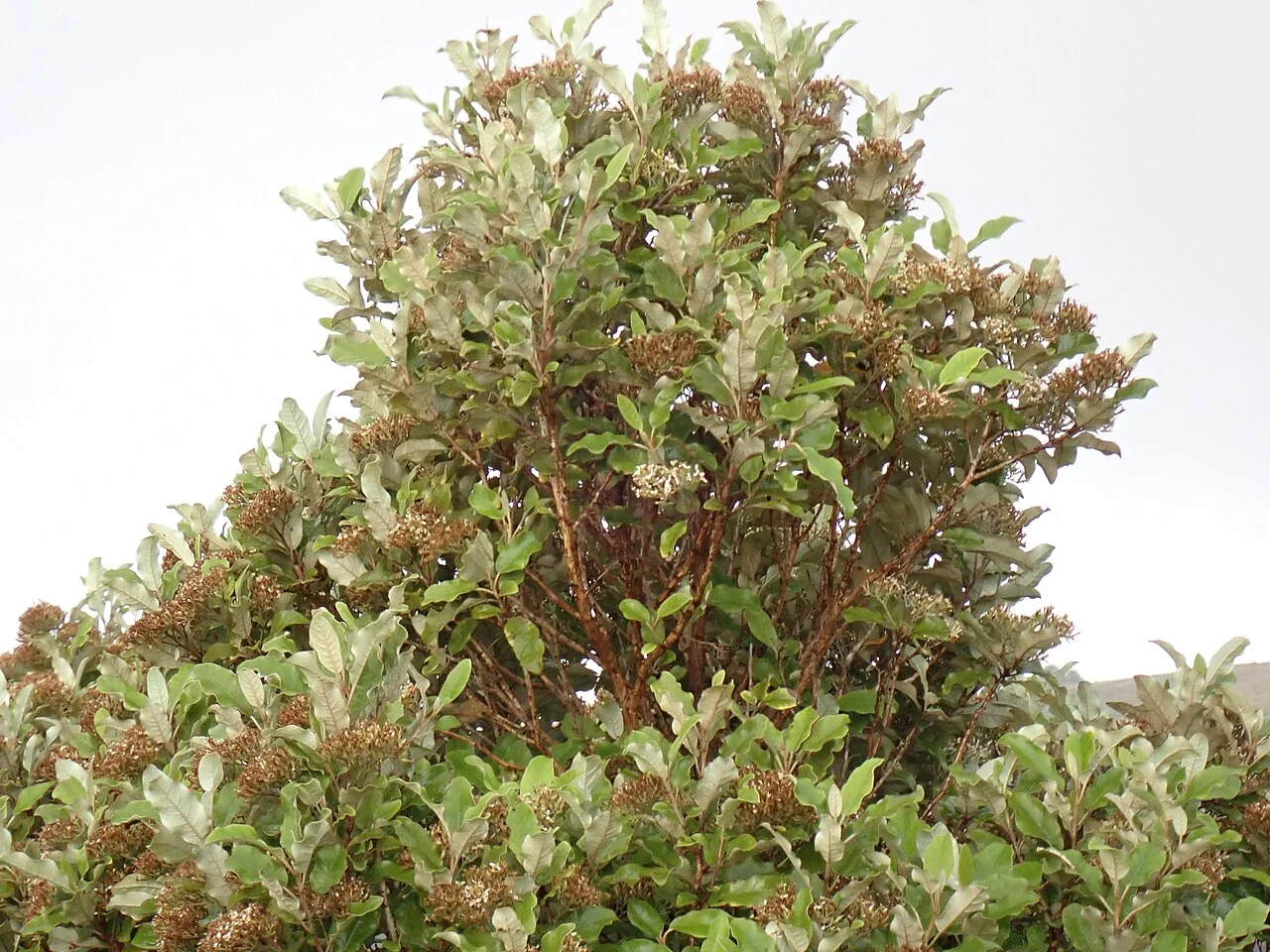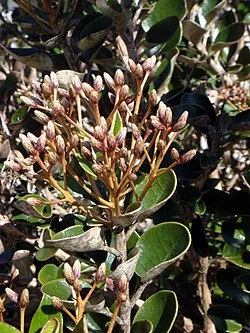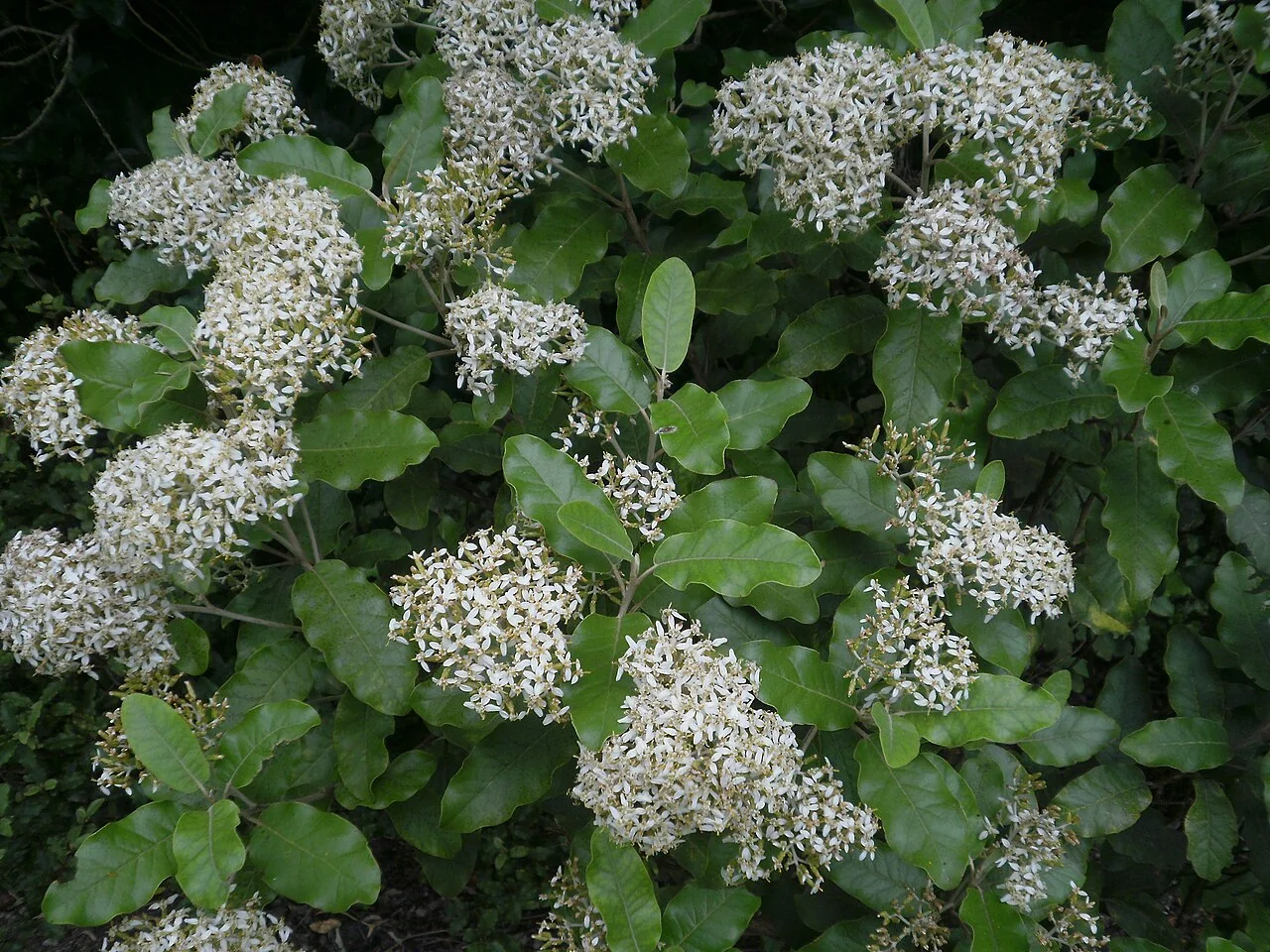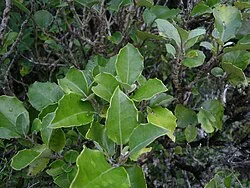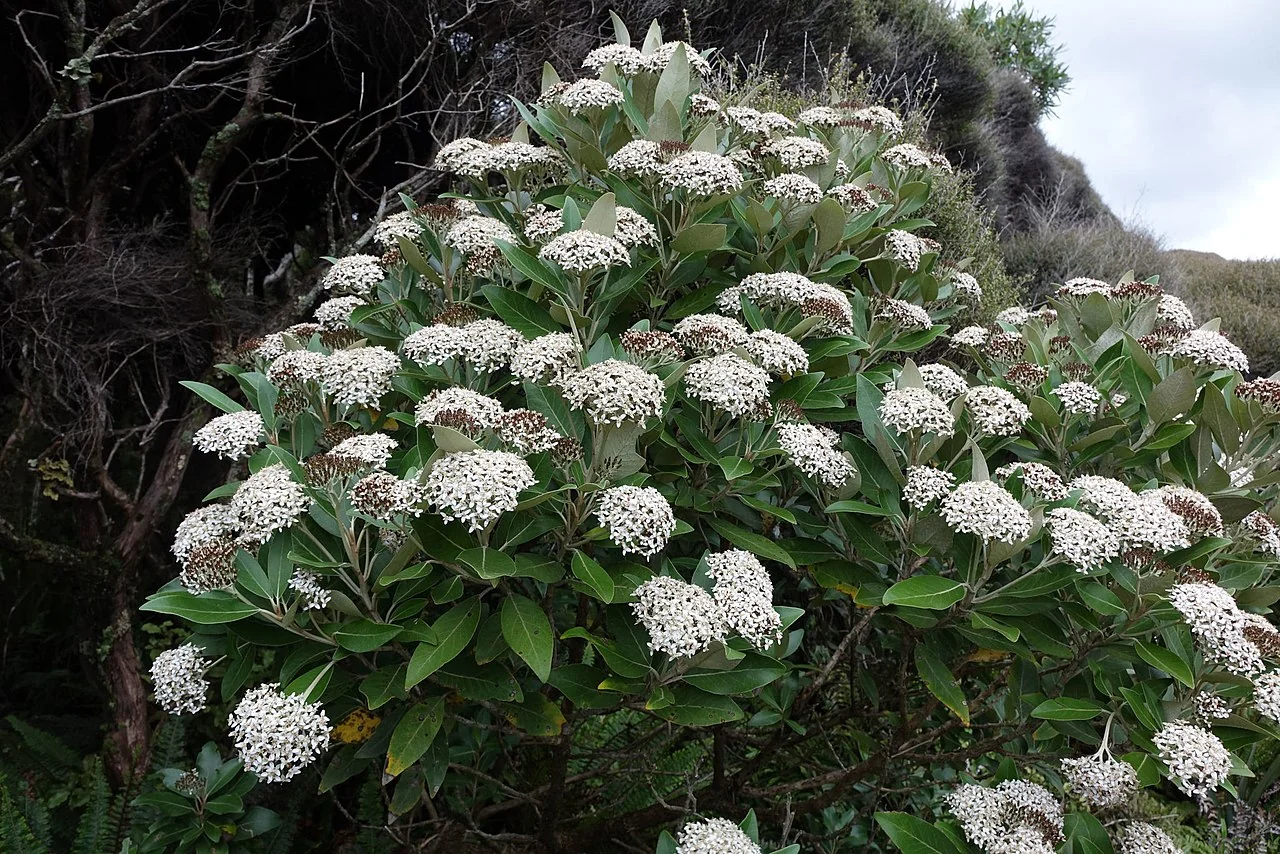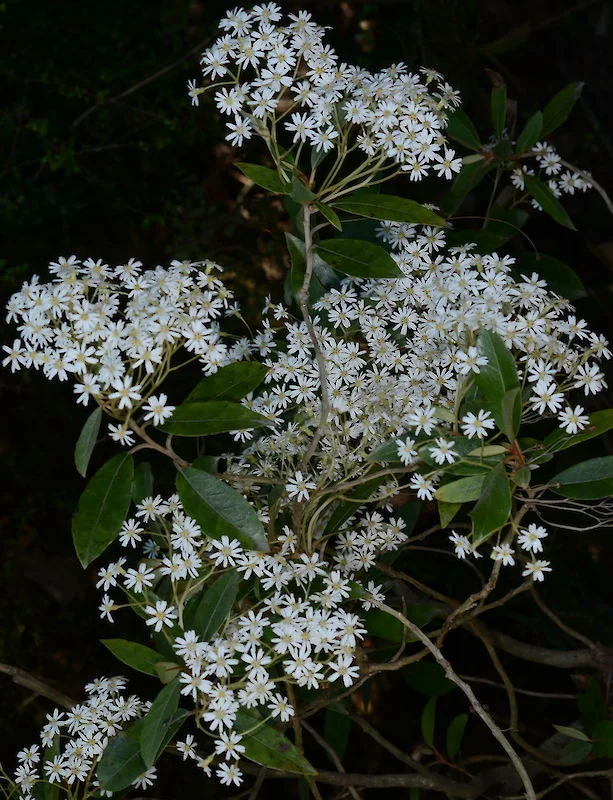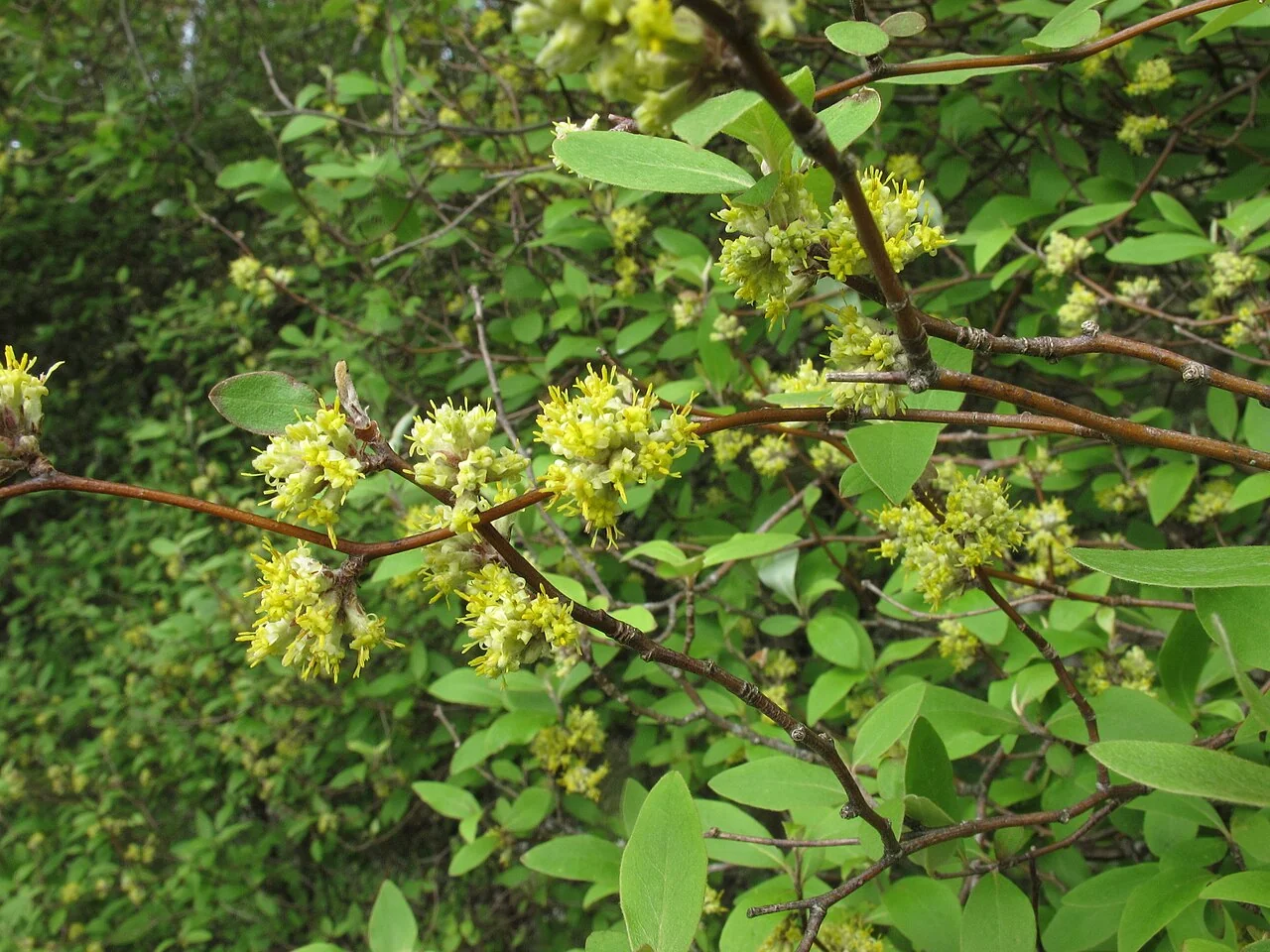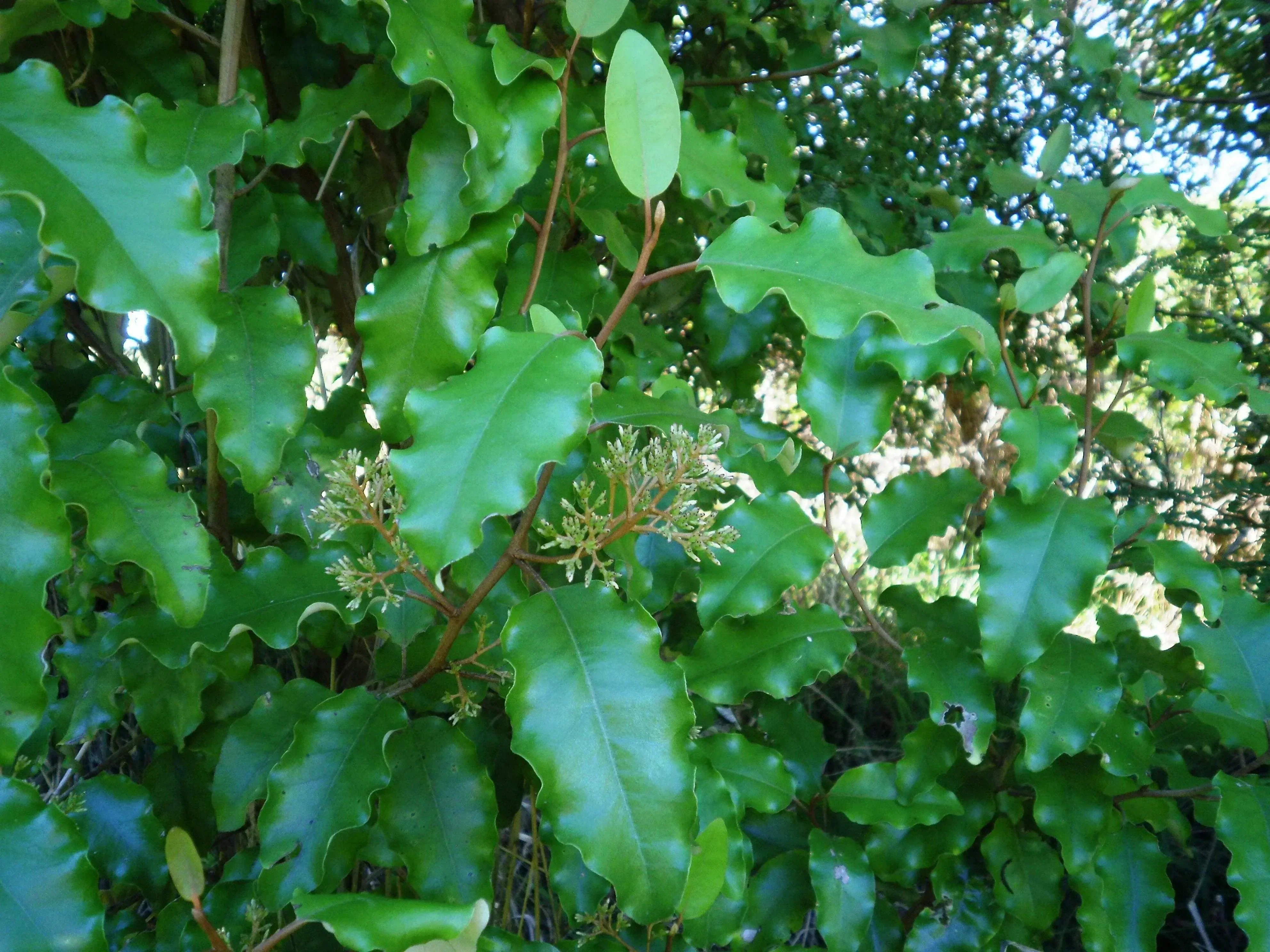
Akiraho
Olearia paniculata
Golden Akeake (scientific name: Olearia paniculata ) Golden Akeake is a native tree daisy that produces masses of small white or cream flowers. Like other Olearia species, it's valued for its hardy nature and ability to provide shelter and nectar for native wildlife. Explore more in the native plants index .

Plant Description
Botanical Features
Akiraho ( Olearia paniculata ), also known as golden akeake, is an evergreen shrub or small tree indigenous to New Zealand. It can grow up to 6 meters tall and has an upright, bushy habit, often forming a rounded or columnar shape. The plant features reddish twigs and wavy-edged, oval-shaped leaves that are typically 3-10 cm long and 2-4 cm wide. The upper surface of the leaves is olive-green and leathery, while the underside is pale and felted (white to buff). The twigs are grooved on the upper surface and angular in cross-section. Small, white, daisy-like flowers appear in dense clusters in late summer to early autumn (fall). These flowers are fragrant and attract pollinators.
Quick Facts
Overview
| Scientific Name | Olearia Paniculata |
|---|---|
| Height | 2-6 m |
| Spread | 2-4 m |
| Water Needs | Low to moderate |
| Light | Full sun to partial shade |
| Frost Tolerance | Moderate to good |
| Salt Tolerance | Moderate |
| Growth Rate | Moderate |
| Lifespan | Long-lived |
Climate Best Suited to
Regional climate suitability across major New Zealand cities.
Regional Suitability
| City | Climate Suitability |
|---|---|
| Whangārei | Good |
| Auckland | Good |
| Hamilton | Moderate |
| Tauranga | Good |
| Rotorua | Moderate |
| Gisborne | Ideal |
| New Plymouth | Good |
| Napier | Ideal |
| Whanganui | Good |
| Palmerston North | Good |
| Wellington | Ideal |
| Nelson | Ideal |
| Christchurch | Ideal |
| Dunedin | Good |
| Invercargill | Moderate |
Natural Habitat
Akiraho is a versatile shrub or small tree endemic to both the North and South Islands of New Zealand. It is commonly found in coastal lowland to lower mountain scrublands, as well as mature and regenerating forests and forest margins. It is particularly well-suited to dry soils and windy, coastal areas, demonstrating high tolerance to salt spray and moderate frosts. This species thrives in full sun to partial shade and requires well-draining soil, as it cannot tolerate wet or poorly drained conditions.
Plant Conservation
Olearia paniculata , also known as akiraho or golden akeake, is a small evergreen tree or shrub native to New Zealand. It is endemic to both the North and South Islands, typically found in the east from East Cape to South Canterbury. The conservation status of Olearia paniculata is currently classified as "Not Threatened" under the New Zealand Threat Classification System (NZTCS), a status it has held since at least 2004. This indicates that the species is not facing immediate risks of extinction in its natural habitat. Despite its "Not Threatened" status, Olearia paniculata holds ecological value. It serves as an important shelter species in native ecosystems and provides food and habitat for insects and birds. The plant is known for its resilience, tolerating wind, salt spray, drought, and poor soils, making it well-suited for coastal and exposed environments. It is also utilized in cultivation, particularly for hedging and shelter belts, and is recognized for its ability to colonize disturbed or open areas, contributing to natural regeneration.
Growing Requirements
Soil Requirements
Adaptable to a range of soils if drainage is reasonable; excels on coastal sands and light loams with organic matter.
Light Requirements
Full sun to light shade; wind-tolerant and suitable for shelter hedges.
Water Requirements
Low-moderate once established; water regularly first 1-2 summers.
Planting Guide
Ideal Growing Conditions:
- Sunlight: Olearia paniculata prefers full sun to partial shade.
- Soil: It thrives in fertile, well-drained soil and can tolerate a range of soil types including chalky, loamy, sandy, and even heavy clay soils, provided there is good drainage. It prefers neutral to slightly alkaline pH but can grow in very alkaline soils. It will not tolerate wet or saturated soils.
- Water: While it needs water to grow, it does not tolerate excessive moisture. It is drought-tolerant once established.
- Climate/Tolerance: Olearia paniculata is highly tolerant of coastal conditions, wind, and moderate frosts, making it suitable for exposed sites. It is hardy to UK zone 9 and tolerates light frosts.
Planting Instructions:
- When to Plant: The best time to plant is after autumn rains when the soil is moist and warm, allowing plants to establish before winter. This helps them withstand dry periods in the following summer.
- Preparation: Always choose healthy, well-grown plants. Before planting, ensure the root ball is saturated. Dig a hole twice the diameter of the root ball. If planting in clay soils, improve drainage by adding extra topsoil and raising beds. Incorporate coarse sand, bark, compost, or other organic material to improve soil structure. It is generally desirable to plant trees into slightly raised beds of well-cultivated soil to improve drainage and provide well-aerated soil for near-surface roots.
- Planting Depth: Remove the planter bag or pot with minimal root disturbance. Trim any broken roots and plant at the same level as in the container.
- Watering After Planting: Firm in the soil around the plant and water thoroughly once planted. Young plants require thorough watering during dry periods for the first two to four years until established.
- Staking: Staking may be necessary for tall plants or those in windy positions to stabilize the root ball until established. Position stakes in the hole before planting and place the plant between them.
Ecological Role
Olearia paniculata plays a crucial ecological role as a late-season nectar source and structural foundation species in New Zealand's coastal and forest edge ecosystems. This hardy shrub excels in challenging environments where many other plants struggle, making it invaluable for natural succession and habitat restoration projects across both main islands.
Pollination and Wildlife Support
- Late-season nectar hotspot: The abundant clusters of small white daisy flowers bloom from late summer through autumn, providing essential nectar when many other plants have finished flowering, supporting native bees, butterflies, moths, and other pollinators during critical late-season periods.
- Beneficial insect sanctuary: Dense branching structure creates microhabitats for beneficial insects including predatory beetles, spiders, and parasitic wasps that help control pest populations in surrounding vegetation communities.
- Bird habitat provision: The upright, bushy growth habit offers excellent nesting sites and shelter for small native birds like fantails, silvereyes, and waxeyes, while seed production provides food resources for finches and other seed-eating species.
- Wind pollination support: Robust structure serves as a windbreak that creates calmer microclimates beneficial for more delicate plant species and their pollinators in exposed coastal locations.
Ecosystem Services and Habitat Value
- Soil stabilization: Extensive root systems help prevent erosion on coastal banks, dunes, and disturbed sites while improving soil structure through organic matter addition from leaf drop and root decay.
- Pioneer species function: Tolerance for poor soils, drought, and salt exposure makes it valuable for establishing vegetation on degraded sites, creating conditions that enable other native species to establish and flourish.
- Forest edge dynamics: Naturally occurring at forest margins, it creates transitional habitat zones that support species requiring intermediate light levels and protection from full exposure.
- Coastal protection: Dense growth provides natural barriers against salt spray and strong winds, protecting inland vegetation and reducing the impact of coastal storms on terrestrial ecosystems.
Succession and Restoration Value
- Rapid establishment: Fast growth rate and tolerance for challenging conditions make it excellent for kick-starting ecological restoration projects on degraded coastal and forest edge sites.
- Nurse plant function: Provides shelter and improved growing conditions for slower-growing native species, facilitating natural succession toward more diverse plant communities.
- Seed dispersal hub: Attracts birds that deposit seeds from other native plants, enhancing natural regeneration and biodiversity development in restoration areas.
- Climate resilience: Adaptation to variable moisture and temperature conditions provides stability during climate fluctuations, maintaining ecosystem function when other species may struggle.
Through its multiple ecological functions, O. paniculata serves as a keystone species that enhances biodiversity, supports wildlife populations, and maintains ecosystem resilience in coastal and forest edge environments throughout New Zealand.
Uses and Significance
Coastal Shelter and Hedging Excellence
Olearia paniculata is exceptional for coastal shelter and hedging applications, tolerating wind, salt spray, drought, and poor soils where few other plants thrive. This vigorous grower with its upright, bushy habit creates excellent windbreaks and screens in exposed sites, particularly valuable from East Cape to Oamaru on the east coast and Raglan to Greymouth on the west coast where it naturally occurs. The bright green, crinkly oval leaves with wavy margins provide year-round structure while the fast-growing, low-maintenance nature makes it ideal for large-scale coastal plantings.
Wildlife and Ornamental Value
Every autumn, Akiraho transforms into a nectar hotspot with clusters of sweet-smelling, daisy-like flowers that support local wildlife and pollinators. The striking wavy, golden-green foliage creates impressive landscape presence reaching up to 6 metres, bringing year-round texture to both native and ornamental landscapes. Its tolerance for challenging conditions combined with vigorous growth makes it particularly valuable for establishing shelter in newly developed coastal areas where soil improvement with coarse sand and organic material enhances its performance.
Landscaping Ideas
Akiraho ( Olearia paniculata ) is an exceptional landscaping plant that combines remarkable resilience with outstanding aesthetic appeal, making it one of New Zealand's most versatile native shrubs for challenging garden situations. This hardy performer excels in coastal and exposed sites where many other plants struggle, while delivering year-round structure and seasonal wildlife spectacle that enhances both formal and naturalistic landscape designs.
Coastal and Windbreak Applications
- Premier coastal hedging: Exceptional tolerance for salt spray, strong winds, and poor soils makes akiraho the ultimate choice for seaside gardens and exposed coastal properties, creating robust, evergreen boundaries that withstand harsh maritime conditions while maintaining year-round beauty.
- Wind-resistant shelter belts: Rapid growth to 6 meters combined with dense, upright habit creates effective windbreaks that protect tender plants and outdoor living spaces, while the flexible branches resist wind damage that often affects rigid barrier plants.
- Erosion control specialist: Extensive root system stabilizes slopes, coastal banks, and disturbed sites, making it invaluable for preventing soil loss on challenging terrain while establishing attractive vegetation cover.
- Maritime boundary definition: Golden-green wavy-margined leaves with distinctive white undersides create striking formal hedges that maintain crisp lines even in challenging coastal conditions, perfect for property boundaries and garden room divisions.
Formal Garden Design
- Structured hedging excellence: Responds beautifully to regular trimming for formal hedge applications, developing dense, neat growth that creates perfect garden boundaries, screening, and architectural plant features with minimal maintenance requirements.
- Specimen tree features: Individual plants create impressive focal points with attractive form reaching up to 6 meters, showcasing the distinctive crinkly oval leaves and seasonal autumn flowering displays that add texture and seasonal interest to landscape compositions.
- Mixed border integration: Excellent backbone plant for mixed native plantings, providing reliable evergreen structure that supports more delicate perennials and seasonal plants while contributing late-season nectar resources.
- Container cultivation: Adapts well to large containers for patios, terraces, and courtyards, enabling moveable screening and seasonal displays while maintaining the distinctive wavy-leaf character and compact growth habit.
Wildlife and Ecological Landscaping
- Pollinator paradise creation: Autumn flowering provides crucial late-season nectar when most other plants have finished blooming, making it essential for supporting native bees, butterflies, and beneficial insects throughout the critical late-summer period.
- Bird habitat development: Dense branching structure offers excellent nesting sites and shelter for small native birds, while seed production supports finches and other seed-eating species, creating dynamic wildlife activity zones.
- Native plant community anchor: Excellent foundation species for establishing authentic New Zealand plant communities, providing structure and shelter that enables other native species to establish and thrive in restoration projects.
- Biodiverse edge creation: Natural adaptation to forest margins makes it perfect for creating transitional zones between different habitat types, supporting species requiring intermediate light levels and protection from full exposure.
Low-Maintenance Landscape Solutions
- Drought-tolerant screening: Once established, requires minimal irrigation even in challenging dry conditions, making it ideal for water-wise landscapes and areas with limited maintenance capacity while maintaining dense, effective screening.
- Fast establishment benefits: Rapid growth rate means quick results for new landscapes and screening requirements, while tolerance for poor soils reduces the need for extensive soil preparation and ongoing fertilization.
- All-season appeal: Evergreen foliage provides consistent year-round structure, while distinctive leaf shape and autumn flowering ensure visual interest throughout all seasons without requiring seasonal replacement or intensive care.
- Climate adaptability: Performs well throughout New Zealand's diverse climate zones, from coastal Northland to inland Canterbury, providing reliable landscape performance regardless of local weather patterns and microclimatic variations.
Design Integration Tips
- Spacing recommendations: Space plants 1-2 meters apart for hedging applications, 3-4 meters for informal screens, and allow 4-6 meters spacing for specimen development, ensuring adequate air circulation and optimal growth potential.
- Companion planting: Combines beautifully with other coastal natives like Coprosma species, Hebe varieties, and native grasses, creating layered plantings that provide diverse textures and extended flowering seasons.
- Maintenance timing: Trim after autumn flowering to maintain shape and encourage dense growth, with additional light shaping in late winter if required, ensuring optimal flowering and wildlife value while maintaining desired form.
- Site optimization: Performs best in full sun with excellent drainage, making it perfect for elevated sites, sloping ground, and areas with challenging soil conditions where other plants might struggle to establish.
Seasonal Care Calendar
Spring
Plant/clip to shape; feed with compost.
Summer
Water new plants in dry spells; light trim after flowering.
Autumn
Formative pruning for hedges.
Winter
Minimal care; ensure drainage.
Pruning and Maintenance
Techniques and Timing
Akiraho clips exceptionally well, making it ideal for formal hedge maintenance and coastal screening applications. The vigorous, upright growth habit responds beautifully to regular pruning after the autumn flowering period, which maintains dense, effective windbreaks. Formative pruning during establishment helps shape the characteristic bushy habit, while ongoing maintenance keeps screens at desired heights. Avoid cutting back to bare wood as the fast-growing nature means regular light clipping is more effective than heavy renovation. The low-maintenance requirements make it perfect for large-scale coastal shelter plantings where minimal intervention is preferred.
How to Grow Akiraho
Akiraho is a robust native shrub or small tree that creates spectacular displays of masses of small white or cream daisy flowers, typically blooming prolifically in late summer and autumn. This hardy member of the Asteraceae family is naturally found in forest margins, scrublands, and coastal areas throughout New Zealand, where it has adapted to challenging conditions including wind, drought, and poor soils. Akiraho is particularly valued in cultivation for its fast growth, reliable flowering, and exceptional wildlife value, providing crucial late-season nectar when many other plants have finished blooming, while its dense branching structure offers shelter for small birds and beneficial insects throughout the year. Understanding its propagation methods is key to successfully growing this delightful species.
From Cuttings
Semi-hardwood cuttings are a reliable and efficient method for propagating Akiraho, ensuring that new plants retain the exact characteristics of the parent. Take 8-12 cm cuttings from healthy, non-flowering shoots in late summer from current season's growth. Dip in rooting hormone and place in a well-draining propagation mix. Maintain consistent humidity with misting or enclosed propagation chambers. Successful rooting typically occurs within 4-6 weeks under warm, humid conditions. Once rooted, the new plants can be potted on and grown in a sheltered environment until they are ready for planting.
From Seed
Propagating Akiraho from seed is a viable method, though it requires fresh seeds and careful attention to conditions. Collect fine seed from dried flower heads in late autumn, storing in cool, dry conditions until sowing in spring. Surface-sow without covering on a free-draining seed mix, as seed requires exposure to light for optimal germination. Maintain consistent moisture without waterlogging, with germination typically occurring within 2-4 weeks under suitable conditions of 18-20°C. Seedlings develop quickly and transplant readily when large enough to handle safely. This method is crucial for maintaining genetic diversity and for large-scale restoration projects.
Pests and Diseases
Akiraho ( Olearia paniculata ) is renowned for its exceptional hardiness and disease resistance, making it one of New Zealand's most robust native shrubs for challenging growing conditions. This natural resilience stems from its adaptation to harsh coastal environments where it faces constant exposure to salt spray, strong winds, and variable moisture conditions, resulting in a plant that rarely experiences serious pest or disease problems when grown in appropriate conditions.
Natural Disease Resistance
- Exceptional hardiness: Akiraho has no known serious pests or diseases, a remarkable characteristic that makes it virtually maintenance-free in most garden situations and particularly valuable for low-maintenance landscapes and large-scale plantings.
- Coastal adaptation benefits: Natural tolerance for salt spray, wind, and challenging soil conditions has resulted in strong resistance to environmental stresses that commonly weaken other plants and make them susceptible to pest and disease problems.
- Drought tolerance advantages: Once established, excellent drought resistance means the plant maintains vigor during dry periods, avoiding the stress-related weakness that often predisposes plants to pest infestations and disease issues.
- Strong natural defenses: Dense, waxy foliage and robust branching structure provide natural barriers against many common garden pests while the plant's vigorous growth quickly recovers from any minor damage.
Preventive Cultural Practices
- Drainage optimization: The most critical aspect of maintaining healthy akiraho is ensuring excellent drainage, as waterlogged conditions represent the primary threat to plant health and can lead to root rot problems in heavy, poorly-drained soils.
- Appropriate site selection: Plant in full sun to partial shade locations with good air circulation, avoiding areas prone to water accumulation or poorly-ventilated spots that might encourage humidity-related issues.
- Proper spacing: Allow adequate spacing between plants (1-2 meters for hedging, 3-4 meters for screening) to ensure good air circulation and prevent overcrowding that could create conditions favorable for pest development.
- Mulching benefits: Apply organic mulch around plants to maintain consistent soil moisture, suppress weeds, and create healthy growing conditions that support natural pest resistance.
Minor Potential Issues
- Occasional aphids: While rare, small populations of aphids may occasionally appear on new growth during spring, particularly during periods of lush growth. Monitor regularly and treat with insecticidal soap if populations become problematic.
- Environmental stress symptoms: Overwatering can cause yellowing leaves and reduced vigor, while inconsistent watering during establishment may lead to wilting or leaf browning that can make plants more susceptible to minor pest issues.
- Grazing animal damage: Goats, cattle, and sheep may browse foliage, though this is primarily a concern in rural or agricultural settings rather than typical garden environments.
- Scale insects rare occurrence: Occasionally, minor scale insect infestations may occur, appearing as small, immobile bumps on stems. These are easily controlled with horticultural oil applications if detected early.
Monitoring and Management
- Regular inspection: Check plants periodically for any signs of pest activity or stress symptoms, particularly during active growing seasons when early detection enables quick intervention if needed.
- Water management: Maintain consistent watering schedules during establishment while avoiding overwatering that can create conditions favoring root problems or reducing the plant's natural resistance.
- Organic management approach: If minor pest issues occur, use organic control methods such as insecticidal soap, neem oil, or horticultural oils that won't harm beneficial insects attracted to the autumn flowers.
- Stress reduction focus: The best pest and disease prevention strategy is maintaining optimal growing conditions through proper drainage, appropriate watering, and adequate nutrition to keep plants naturally healthy and resistant.
The exceptional pest and disease resistance of akiraho makes it an ideal choice for gardeners seeking reliable, low-maintenance native plants that thrive with minimal intervention while providing maximum landscape impact and wildlife value.
Cultural Significance
Traditional Uses and Values
Olearia paniculata , known by its Māori name Akiraho, holds cultural and ecological significance in Aotearoa New Zealand. Within mātauranga Māori (Māori knowledge), native plants like Akiraho are valued for their role in sustaining the health of the ngahere (forest) and local ecosystems. Beyond its ecological contributions, Akiraho is widely recognized for its practical uses. It is frequently employed as a hedging and shelter plant due to its hardiness, rapid growth, and tolerance to coastal conditions, wind, salt spray, drought, and poor soils. Its dense branching structure provides shelter for small birds and beneficial insects. Ecologically, Akiraho is an important species. It transforms into a "nectar hotspot" in autumn, with clusters of sweet-smelling, daisy-like flowers that support pollinators and local wildlife. It also serves as an important shelter species in native ecosystems, offering food and habitat for insects and birds. Furthermore, Akiraho is often one of the first species to colonize disturbed or open areas, playing a key role in natural regeneration.
Bonus Tip
Expert Growing Advice
Akiraho ( Olearia paniculata ) clips into a superb coastal hedge. For tight, formal lines, shear in late summer after flowering and again lightly in late winter. Deep, infrequent watering encourages wind-firm roots on sandy sites.
